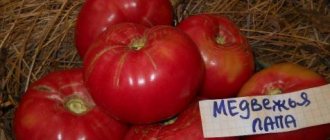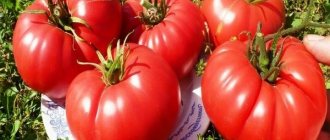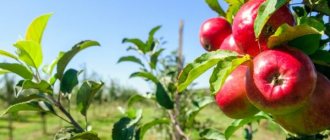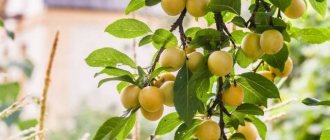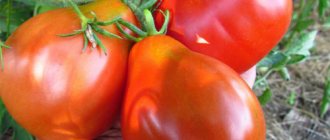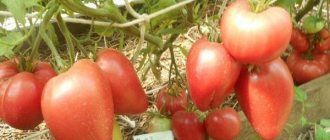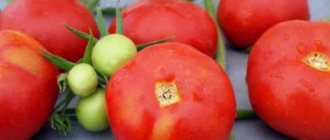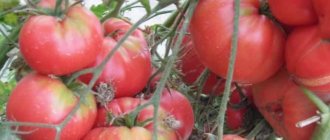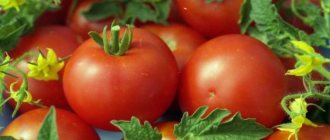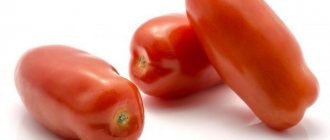Vegetable growing » Tomatoes
0
1214
Article rating
Kira Stoletova
Tomato Gravity F1 is a fairly common variety that belongs to the early greenhouse tomato species. It is semi-determinate and best suited for growing in the spring and summer season.
Description of tomato Gravity
Preparing for landing
The description says that it is best to prepare the soil for planting tomatoes in the fall.
The preparation consists of digging up the soil and adding organic fertilizers. The soil should initially be sufficiently fertile. For growing Gravity F1 tomatoes, sunny areas without drafts and strong winds are ideal. Seedlings can be planted when the soil temperature reaches 20 °C and the air warms up to 25 °C.
Before planting, it is necessary to harden the seedlings by reducing watering and gradually lowering the air temperature. This will help the plant survive in harsher conditions in the future.
The planting process and technology is very similar to other varieties. A hole is dug into which one plant is placed, filled with soil and compacted a little. After which it is necessary to water each bush abundantly
It is important to maintain the required distance so that each plant subsequently receives the required amount of sunlight and heat
Caring for the variety is quite simple. It consists, first of all, in removing weeds and loosening the soil between plants. It must be carried out to prevent the formation of a crust, which will prevent the supply of oxygen to saturate the roots. It is also necessary to take into account the height of the plant, and do not neglect pinching.
Tomatoes Gravitet F1 do not require frequent and abundant watering, especially before fruit formation, as this threatens them with diseases. But the variety needs fertilizing with mineral fertilizers. The first treatment should be carried out ten to twelve days after planting. A mixture consisting of organic matter and minerals is suitable for this. The second and third - with a break of two weeks. They should consist of feeding the plant with dry mineral fertilizers immediately after loosening the soil.
Reviews
Leonid Viktorovich, 45 years old, Volgograd
I saw a photo of the tomato variety “Gravity F1” on the Internet and decided to plant it in my dacha. From the first year I noticed many advantages of this variety over the tomatoes that I had grown previously. The bushes have never gotten sick before. I carry out late blight prevention every year, because I know that if the disease appears, it will be difficult to cure it. I don't use any other products. I fertilize as usual, using only organic matter. The tomatoes are very large and tasty, the flesh is fleshy. You get excellent pickled and pickled tomatoes.
Valentina Sergeevna, 38 years old, Voronezh
For the first time I saw the variety “Gravity F1” from my neighbor. She always finds some new and interesting tomatoes. Then I looked at the description on the Internet and decided to purchase seeds to grow seedlings myself. The seeds quickly sprouted and grew stronger. By the time of planting, the seedlings could barely fit on the windowsills. I planted tomatoes in open ground. The plants quickly took root and began to grow. I fed the bushes a couple of times with superphosphate and organic fertilizers. I collected the harvest with great pleasure, as it was very generous.
Source
Tomato Perun f1 description and characteristics of the variety, cultivation and care with photos
And although the Gravitet F1 variety has strong immunity, it can be affected by the following diseases:
Late blight. This is a dangerous disease for tomatoes. It appears as dark brown or black spots on the stems and leaves of plants. With the subsequent development of the pathological process, the leaf blade becomes dark brown and the stem turns brown. The fruits begin to crack and lose their taste. To combat, use a solution of garlic and potassium permanganate. For 10 liters of warm water, take 250 g of garlic, minced using a meat grinder, 1.5 g of potassium permanganate and 40 ml of liquid soap.
- Brown spot. It affects tomatoes grown in greenhouses. Brown spots and a gray velvety coating form on the inside of the leaves. The affected leaves dry out and the plant dies. The disease can be cured at an early stage of development using a solution prepared according to the following recipe: 10 liters of water, 20 g of copper sulfate, 60 g of colloidal sulfur and 20 g of polycarbacin. Before spraying, add 40 ml of liquid soap to the solution.
- Gray rot. This is a fungal disease that affects fruits at the end of the growing season. Small round spots form on tomatoes. Over time, they increase in size, and brown spots and watery spots form on them. Remove all infected plants, treat the soil and increase the temperature. It is impossible to save diseased bushes.
Dangerous pests include:
- Medvedka. This parasite is brown in color. Its length is 50 mm. It is distinguished by heavily infested digging limbs and shortened elytra. For the fight, an infusion of bitter black pepper is used. Take 10 liters of water and 100-150 g of pepper. Consumption per well is 0.5 l.
- Whitefly. This pest is dangerous for those tomatoes grown in greenhouse conditions. The insect is small in size, body length 1-1.5 mm. The color of adults is yellow, while the larvae are light green. They stick to the leaves and eat them. The drug Fosbecid is used for control. It works great in greenhouses and open ground. To prepare the solution, take 10 liters of water and 10 ml of the drug.
https://www..com/watch?v=wcS8XvQuxPk
Vegetable growers accepted the hybrid into their collection with great pleasure, since disease resistance is another advantage of “Bystryonok”.
The hybrid has increased resistance to:
- verticillium;
- tobacco mosaic virus;
- fusarium wilt.
The hybrid has average resistance to late blight, but due to the fact that it ripens at a very early stage, it manages to produce its products before the massive expansion of the outbreak.
general information
The hybrid is young. Got into variety testing in 2012. It didn’t take long for variety testers to consider the full genetic potential of this tomato; it quickly showed itself and already in 2013 it was already included in the register of breeding achievements of the Russian Federation under number 8756985.
Applicant and originator of the variety is LLC “Vashe Khozyaystvo”, Nizhny Novgorod, Russia.
The tomato hybrid “Bystryonok” is recommended by the variety testing commission as an early ripening (80-90 days), salad, for growing in all regions of the country in open ground, and under film or glass covers in the personal farms of gardeners and gardeners.
Advantages and disadvantages
The advantages of the variety include:
- high productivity;
- large size tomatoes;
- the harvested crop can be transported over fairly long distances;
- the hybrid is quite resistant to most diseases, especially late blight.
Tomato has practically no disadvantages, but the central shoot requires mandatory tying to supports, and the formation of a bush is also necessary. After planting the seedlings in a permanent place, regular watering should be provided, as well as fertilizing in sufficient quantities to obtain larger fruits.
Tomatoes “Bistrenok” reviews, photos, everything suggests that the variety has a whole list of positive qualities:
- early fruit ripening;
- high taste qualities;
- excellent fruit set;
- friendly maturation and return;
- excellent yield;
- disease resistance.
The only disadvantages include the peculiarities of agricultural technology, since the hybrid, despite its determinacy, still needs to be tied up and formed.
Tomato Gravitet F1: characteristics of the variety, features of planting and care
Gravitet F1 is a hybrid tomato variety that has excellent characteristics in terms of yield and appearance. It is not picky about care, so even a beginner can cope with its cultivation. And high immunity to disease only adds to the variety’s popularity.
Description
Tomato Gravity F1, the description of which is quite simple, is an early semi-determinate hybrid, valued by gardeners for its high yield. You can re-grow tomatoes even after picking them for the first time. In the second whorl, the fruits are smaller in size, but just as juicy and tasty. But they just have to be grown in a greenhouse.
- high yield rates;
- beautiful appearance and size of the fruit;
- fast ripening speed - after 2 months you can enjoy juicy tomatoes;
- even in the absence of suitable growing conditions, green spots do not form;
- the ability to grow tomatoes in two steps.
Characteristics of the variety
Gravity F1 grows to a height of 1.7 m. The fruits ripen early - 65 days after planting the seedlings. The plant itself is strong, the root system is well developed, and you should also know:
- Fruit ripening is simultaneous. This is quite convenient for those gardeners who grow tomatoes to preserve for the winter.
- 7-9 brushes are formed on one bush.
- All fruits are round in shape and slightly flattened.
- Their color is dark red, and in the sun they shimmer incredibly beautifully.
- The consistency of the pulp is dense, juicy, and the skin is strong. The presentation of the harvested crop is excellent. Tomatoes tolerate transportation well without losing their appearance or taste.
Description of the tomato variety Gravity with photo
Tomato Gravity is a first generation hybrid (designated F1), bred in Holland. In recent years, it has managed to spread to Russia: it was included in the register of selection achievements in 2011. It is mainly recommended for cultivation in the south and the Black Earth region (possibly in open ground). In other regions, cultivation in greenhouses is allowed. Moreover, it is desirable in the northern regions that they be heated during short-term frosts.
Main characteristics of the Gravity tomato variety:
- semi-determinate (grows with limitation);
- tall (120-150 cm);
- early ripening (fruits are formed in 60-70 days).
The Gravitet tomato bush is tall, with strong shoots and a developed root system. The leaves are deep green in color and have a typical shape and size. Flower racemes from 7 to 9. The inflorescence is of a simple type, the stalk has an articulation. The first of them is laid above the 7th sheet.
4-6 Gravity tomatoes are formed on each brush
Description of fruits
The tomatoes have an almost perfect round shape with slight ribbing (clearly noticeable in the area of the stalk). At the stage of technical ripeness, Gravitet tomatoes are colored light green (dark green closer to the stalk). The color of ripe fruits is bright red. The surface is glossy, without wrinkles.
The tomatoes are quite large - 7-10 cm in diameter, with an average weight of 200-240 g. The cut shows many seed nests (more than 6). However, it is not advisable to collect the seeds; they will not produce fertile offspring, since the Gravity tomato is a hybrid, not a variety.
The pulp is juicy, dense consistency. The taste is pleasant and balanced. There is an unobtrusive sweetness and delicate sourness, and a tomato aroma. The skin is dense, which allows Gravity tomatoes to be used in any direction - left for storage, transported over long distances, sent for canning.
Gravity tomatoes have a very attractive appearance
Characteristics of tomato Gravity
The fruits of this hybrid are formed in a very short time: Gravitet tomatoes reach the stage of technical ripeness within 2-2.5 months after planting the seeds. Therefore, the first harvest can be harvested at the end of May. Tomatoes are sent to a dark place or left to ripen on a branch.
Tomato yield Gravity and fruiting
Data on the yield of the Gravitet tomato vary, but in any case the indicators are very good. If you follow agricultural technology, you can harvest up to 10-12 kg from 1 bush.
| Growing method | Greenhouse | In the garden |
| From 1 bush, kg | 10-12 | 8-9 |
| From 1 m2, kg* | 30-36 | 24-27 |
*On 1 m2 you can freely place 3 Gravity tomato bushes.
To harvest as many tomatoes as possible, it is recommended to grow bushes in a greenhouse (especially in the North-West, the Urals and Siberia). It is also worth observing the basic rules of agricultural technology:
- Don't forget about regular watering.
- Feed the plants.
- Ventilate the greenhouse.
- Form a bush and tie it to a support.
Attention! When growing a Gravity tomato in a greenhouse, you can get 2 harvests per season.
Area of application of fruits
Gravity tomatoes are universal in their use. They are good fresh - for example, for making tomato juice, salad, assorted vegetables and other cold appetizers. Tomatoes can be used for various dishes and preparations:
- sauces;
- soups;
- second courses;
- vegetable caviar;
- lecho.
They are also suitable for whole-fruit canning – pickles, marinating. The peel is durable, so such preparations can be stored for more than one year. However, some fruits are quite large and are best eaten fresh.
Resistance to diseases and pests
Like most hybrids, the Gravity tomato is resistant to major diseases, including:
- late blight;
- verticillium;
- tobacco mosaic;
- fusarium wilt.
As a preventative measure, it is sufficient to apply standard measures:
- Do not over-water.
- Ventilate the greenhouse.
- Treat the seedlings with a fungicide a week before transplanting.
- Periodically inspect the bushes for signs of diseases or pests - re-treat if necessary.
Hybrid characteristics
An early-ripening, semi-determinate f1 tomato is intended for growing mainly in film and polycarbonate greenhouses, and in open beds. Seeds of Dutch selection. It takes 50–60 days from planting seedlings in the ground to harvesting. The bush requires gartering and shaping.
The height of the plant at maturity reaches a height of 1.7 meters. The root system is highly developed, the branches are powerful. One plant produces 8–9 clusters of fruits.
When ripe, tomatoes weigh 170–250 grams, so branches with fruits need to be tied up. One bunch will bear from 3 to 7 fruits at the same time. The fruits are smooth, slightly flattened, shiny. Mature ones have a bright red color; there is no green spot on the stalk. The taste is sweet, with sourness. The pulp is dense and juicy with a small number of small seeds.
Fruits of universal use. Reviews say that they are used to make juices, sauces and pastes. Marinated, salted and dried for seasoning. And excellent transportable qualities help tomatoes to be successfully sold in markets and stores. As you can see, this hybrid has solid positive qualities.
Among the short ones we note the following
Tomato up to 40 cm high, productive, resistant to cold weather and disease. The tomatoes are round, red, and have a wonderful taste. Weight – 120-130 grams. Characterized by early maturation.
Bagheera F1
A bush variety that bears fruit well in open ground. The fruits are dense, round, of high taste. Color – red, weight – 100-180 grams. Used for salads and canning.
Superclub
It grows up to half a meter in height, the plant is squat and stocky. Does not require removal of stepsons, unpretentious. The fruits are pink, tasty, weighing 80-120 grams.
An intermediate place between determinate and indeterminate varieties is occupied by semi-detas. Their growth exceeds 100-120 cm, but can stop at any time. Tomato seeds Gravitet F1, Eagle's Beak, Baron, and Golden Queen showed good results.
Eagle beak
Tall tomato with high yields. Recommended for greenhouses. The fruits have an interesting elongated shape, similar to hearts with a “beak”. Color – crimson, weight – 400-500 grams. The largest tomatoes are in the first clusters, then a little smaller. The taste is very good.
Gravity F1
A productive, unpretentious hybrid with fruits of excellent taste. Ripening time is early (70-80 days). The fruits are round in shape, weighing 200-250 grams, growing in clusters.
Golden Queen
Excellent fruit set in any season, an unpretentious tomato with beautiful bright yellow fruits. The weight of tomatoes is 600-700 grams, there are ribs on the fruits. Intended for salads; due to its high carotene content, it is recommended for baby and diet food.
Indets are distinguished by their productivity, powerful and tall bushes, and require intensive feeding and proper care. They must be planted in greenhouses, taking into account the height of the shelters and plants.
De Barao
This tomato, popular in various regions, needs no introduction. Height - up to 2-4 meters, ripening time is late (120 days). Many varieties have been developed with fruits of different colors: orange, black, pink, red, yellow. A fruitful, tasty variety.
Kronos F1
A productive mid-late hybrid that has shown excellent results when grown in film greenhouses. The fruits are round, red, weighing 150-170 grams. Yield indicators – 8 kg per 1 sq. meters.
Babushkino
Collection tomato, with excellent yield indicators. Indet, height up to 1.8 meters, is formed into 2-3 trunks. The tomatoes are very large, up to 500-600 grams, sweet. A bush with such a height requires a garter.
Chukhloma
A variety whose fruits are excellent for whole-fruit canning. The bush is powerful, up to 2.3 meters, hung with long trusses with fruits of an original elongated shape. Color – red-orange, weight – 100-120 grams. Tomatoes contain large amounts of carotene. From 1 sq. meters, up to 5.5 kg of fruits are collected.
Advantages and disadvantages
Good yield Resistance to fusarium and cladosparia blight Unpretentious to climatic conditions Long shelf life when fresh
Excessive growth of stems Need to be tied to supports
Large varieties
This category includes tomatoes with especially large fruits.
King of Kings. This is a tall indeterminate hybrid.
It is distinguished by its late ripening period, which is compensated by its size (800 g), as well as the taste and physical properties of the fruit.
Tomatoes are sugary, fleshy, and can easily be transported. Retain their shape and taste for a month. More information about the “King of Kings” tomato.
Sugar bison. A tall tomato bush with weighty pink tomatoes.
A garter or support formation is required.
The average weight of round or heart-shaped fruits is 300 g.
The variety has an excellent taste and is universal in its economic purposes. Sugar bison is considered mid-season.
Mammoth. An early ripening variety, not demanding of care and maintenance conditions.
These tomatoes do not have a beautiful presentation, so they are consumed fresh or processed.
Mammoth is resistant to heat and drought, but its fruits often crack.
Pest and disease control
This hybrid has very good immunity. Therefore, preventive treatment against diseases is not necessary. To be on the safe side, you can spray the seedlings with fungicides (a few days before transplanting). Use any effective drug:
- Bordeaux mixture;
- "Skor";
- "Ordan";
- "Fitosporin";
- "Maksim".
After replanting, plants should be inspected for traces of insects. When first detected, they are removed manually or washed off with gentle water pressure. In the future, you will need to treat the Pomegranate tomato bushes. To do this, use home remedies (a solution of tobacco dust, wood ash, soap shavings, infusion of onion peels, chili peppers) or insecticides:
- "Fitoverm";
- "Biotlin";
- "Karbofos";
- "Aktara";
- "Vermitek".
Important! It is better to carry out processing late in the evening, in the absence of wind and rain. After this, the fruits can be collected after the waiting period (several days) specified in the instructions for the drug
Hybrid characteristics
An early-ripening, semi-determinate f1 tomato is intended for growing mainly in film and polycarbonate greenhouses, and in open beds. Seeds of Dutch selection. It takes 50–60 days from planting seedlings in the ground to harvesting. The bush requires gartering and shaping.
The height of the plant at maturity reaches a height of 1.7 meters. The root system is highly developed, the branches are powerful. One plant produces 8–9 clusters of fruits.
When ripe, tomatoes weigh 170–250 grams, so branches with fruits need to be tied up. One bunch will bear from 3 to 7 fruits at the same time. The fruits are smooth, slightly flattened, shiny. Mature ones have a bright red color; there is no green spot on the stalk. The taste is sweet, with sourness. The pulp is dense and juicy with a small number of small seeds.
Fruits of universal use. Reviews say that they are used to make juices, sauces and pastes. Marinated, salted and dried for seasoning. And excellent transportable qualities help tomatoes to be successfully sold in markets and stores. As you can see, this hybrid has solid positive qualities.
Characteristics of the variety
The hybrid has high yields and is unpretentious to growing conditions and technology. It develops and bears fruit well in temperate climates. The first fruits appear 60-68 days after planting the seedlings.
Description of the fruit
Tomatoes are medium-sized, weighing about 180-250 grams, at the beginning of fruiting they can reach three hundred. Tomatoes have short internodes, so they are often sold in bunches. The fruits are round in shape, slightly ribbed and quite hard. They have a rich dark red color and a beautiful shiny surface.
Gravitet F1 tomatoes have excellent taste and pleasant aroma. The fruits are characterized by resistance to the formation of green and white spots on them. Thanks to this, they are preserved for a long time and are unpretentious for transportation.
Description of the bush
The characteristic indicates that the plant belongs to the generative type. This hybrid has a fairly tall bush (1.5 -1.7 meters) and a powerful root system. Thanks to this, the plant is able to form 7-9 bunches and delight with a good harvest of tomatoes all season.
The Gravitet F1 variety is quite strong and unpretentious, but nevertheless requires sufficient lighting. Therefore, for best results, it is recommended to plant 2-3 plants per square meter to allow the sun's rays to reach more than just the surface of the leaves.
According to ripening time
Ripening time is the most important characteristic of tomato classification. The timing of sowing seeds and planting seedlings, as well as caring for the plant, depends on it.
Early ripening
Tomatoes that ripen within 90–95 days after seed germination are considered early ripening.
Leopold F One of the most popular tomatoes.
This is a compact bush with medium fruits. The tomatoes are round and bright red.
The advantage of the hybrid is its early ripening. At the same time, the fruits turn red evenly. Leopold F1 shows excellent transportability and keeping quality, as well as a stable yield of 3 - 3.5 kg per bush.
Max ripens on average 95 days from the moment the seeds are planted.
The bush does not grow too tall (about 70 cm).
The fruits are bright red and have a pleasant appearance.
It is universal in its economic purpose. Max can be grown both in a greenhouse and in open ground.
Lyubasha ripens less than 3 months after sowing.
It has medium-sized fruits (150 – 200 g).
Tomatoes of this variety are suitable for canning and salads. They store well without losing their taste.
Lyubasha can be grown throughout Russia. More about the tomato variety “Lyubasha”.
Mid-early
This category conventionally includes those tomatoes that ripen for 100 days. Mid-early varieties can be grown in open ground.
Mid-season
The newcomer grows well in open ground.
This is a simple and easy-to-care tomato.
The fruits have different shapes, but are generally similar to plums.
The weight of one tomato is 100 g.
Novichok is considered a productive variety. Its fruits are well suited for preservation.
Parsley the gardener. Super determinate tomato with low bushes.
The fruits are fleshy, elongated, with dense pinkish skin.
They taste sweet.
For its ripening period it has a good yield (up to 6 kg per 1 sq. m).
It retains its presentation for 10 – 12 days. Read more about the “Parsley gardener” tomato.
Fidelity F This is a determinate hybrid.
The bush grows a little more than a meter in height. The fruits of the hybrid are dense, classically round in shape.
The weight of 1 tomato is about 180 g.
This hybrid is resistant to some fungal diseases.
Tomatoes are quite versatile, but are best suited for salads and juice production.
Late ripening
Tomatoes in this category ripen at 120 days. In the middle zone, it is recommended to grow in greenhouses, although in a warm year you can get a good harvest in open ground.
Finish. A low determinate variety with tomatoes of a “classic” slightly flattened shape.
The fruit sizes are average.
Tomatoes have an excellent taste and are suitable for pickling. Their beautiful appearance gives them additional commercial value.
Another advantage is high yield.
Date fruit. Small-fruited variety “cream”. The bush bears fruit abundantly.
Tomatoes have a beautiful shape and have a high commercial value.
The taste is sweet.
Hybrids have different colors (yellow, orange).
Vladimir F1. A low bush with growing clusters of rounded fruits.
Tomatoes have a sweetish taste.
The hybrid is considered universal in terms of economic purposes.
Often grown in the southern regions of Russia.
For open ground
Varieties of low-growing tomatoes for open ground can also be divided into several categories and the best are ready for consideration:
"Mirsini F1"
The tomato plant has a very large leaf that protects the fruit from the scorching sun. The smooth-skinned, heart-shaped tomato has a medium to intense body. A bright red tomato has 6 chambers, sometimes more. Weight up to 230 g, excellent taste and excellent transportability. The plant is resistant to a range of diseases.
"Simona F1"
Over 10 years on the market it has become a favorite for many vegetable growers. The flat-round tomato has light ribs, is dense and does not crack under any conditions. Red with four nests, weighing up to 300 g and excellent taste.
"Three Bears F1"
It is difficult for a small bush to hold fruits of 250 g each, so it requires a garter. The tomatoes are round, dense, slightly ribbed, with 6 cavities and a wonderful taste
"Ivanhoe F1"
Flat-round fruits weighing up to 350 g have 6 or more nested formations. Tomatoes of this variety have an excellent taste and a beautiful, even, pink color.
Medium size
If you are looking for low-growing tomatoes for open ground, ones that can be preserved, juice or sauce can be prepared, then you can consider the following:
"Roseanne F1"
The plant is so productive that it cannot independently, without fixation, hold a marketable crop of fruit. Early with medium leaves and rounded fruits with light ribbing and medium density. The tomato is pink in color with nests from 4 to 6 and weighing up to 150 g. The excellent taste will delight even a gourmet. And the high marketability and resistance to cracking will make you fall in love with the variety and cultivate it constantly.
"Globe F1"
The variety is suitable for pickling and salads. A small leaf will allow you to be well heated by the sun. The fruit is flat-round, red, with a weak rib, 4 lobes and weighs up to 120. The taste, according to tasters, is good.
Sustainable and productive
Good tomatoes for open ground, low-growing and very disease-resistant, can be represented by the following:
"Gavroche"
The height of the bushes will not be higher than 50 cm, and the variety will produce fruits already on the 83-85th day after germination. The variety can be easily distinguished by its slightly corrugated leaf. The fruit of a classic red tomato weighs up to 50 g. Fruiting is very friendly, and the tomatoes are tasty both fresh and canned.
"Yard"
Cuboidal, red tomato, weighing up to 110 g with slight ribbing and good density. The tomato taste is excellent, 3-4 nests. Suitable for both fresh consumption and preservation.
The plant is not very powerful, the shoots cannot support a huge harvest on their own and need to be taken care of by staking and shaping.
"Coral"
The ripening period is medium early. A plant with weak foliage and a semi-spreading habit. The fruit has a cylindrical shape, a red, smooth surface. The weight of an average tomato is 85-95 g. The fruits have a good taste both fresh and canned.
By purpose
Depending on their properties, different varieties of tomatoes are better suited for different purposes. Juicier varieties are better used for making tomato juice.
Those that do not tolerate transportation well and do not have high shelf life are best used for preparing salads, etc.
Salad and for fresh consumption
This variety usually includes tomatoes that do not tolerate transportation well or do not retain their taste when preserved.
Puzata hut. These are ribbed tomatoes weighing about 300 grams.
The fruits have good taste. This is a productive variety (up to 12 kg per 1 sq.m.).
Disadvantage: Puzata Khata tomatoes can crack. Even more information about the “Puzata Khata” tomato is on our website.
Danko Heart-shaped. Bush with large heart-shaped fruits.
The yield of the variety is average, which is compensated by the high taste of the tomatoes.
Danko is practically unsuitable for transportation due to its high susceptibility to cracking.
A heavenly delight - juicy tomatoes with good taste.
The variety is resistant to some fungal diseases.
With careful care it can produce up to 9 kg per 1 sq. m.
This is one of the few large-fruited tomatoes suitable for long-term storage and transportation.
For canning
For canning, medium-sized tomatoes of regular shape and not prone to cracking are most suitable.
Countryman is a low bush with medium-sized tomatoes.
The fruits are dense, with noticeable sourness.
They retain their shape well even after preservation and heat treatment. Suitable for growing in the Middle Zone.
Nikola. A variety with average yield. Belongs to early ripening.
It is distinguished by the same size of fruits and uniform ripening.
Productivity is slightly above average. Resistant to temperature changes, but susceptible to fungal diseases.
Yuryevsky is a variety resistant to fungal diseases.
Productivity is good.
It bears fruit for a long time.
Tomatoes are medium-sized, fleshy, round, with thick skin
For recycling
For processing into juices and sauces, it is best to grow tomatoes with fleshy, juicy fruits with a high sugar content.
Azores red. Large-fruited indeterminate variety.
It has high productivity.
The fruits are ribbed, dense, with fleshy pulp. They have a pleasant, traditional tomato taste. There is a slight sourness.
Altai masterpiece. Indeterminate variety.
Forms large fruits that are distinguished by slight ribbing at the top.
Ripens early and bears fruit well.
The fruits are well processed, leaving virtually no “waste”.
Success. Low bush with early fruit ripening.
It is considered a standard variety. Resistant to diseases.
The fruits are “plums”, medium in size with thick skin.
Suitable for transportation. They have a slight sourness.
Universal purpose
This category includes tomatoes that can be used for different purposes.
Ladies' man. Pepper-shaped tomatoes.
This variety is quite demanding in care, but is characterized by high shelf life and transportability.
The fruits can be used for salads and for preservation. Tomatoes have a good taste. Read more about the Ladies' Man tomato variety.
Andromeda F Early ripening hybrid.
Medium sized fruits.
This is a fertile variety that is often more susceptible to late blight.
Therefore, it requires special attention when growing.
The F1 prima donna matures very quickly. The fruits are small, heart-shaped.
They have acceptable taste for early ripening varieties.
Not susceptible to diseases.
Suitable for growing in regions with harsh climates.
Brief description of other interesting varieties
In addition to the Visibly-Invisibly variety, there are other interesting varieties of tomatoes, the characteristics and descriptions of which may be of interest to beginners and experienced gardeners.
The Bayan tomato is mid-season with large fruits weighing up to 500 grams. Ideal for salads due to the excellent sweet taste of meaty tomatoes.
The Granadero tomato is a high-yielding, mid-season with even, smooth, plum-shaped tomatoes. It has a sweet, pleasant taste and bright color, as well as stability during storage and transportation.
The Minotaur tomato is an early ripening plant with large, dense, fleshy fruits. Juicy and sweet-tasting tomatoes are suitable for making juice and paste. The variety is resistant to diseases.
The Leopold variety can be characterized as a low, unpretentious plant that is resistant to common diseases. Tomato is recommended for beginner gardeners. Early ripening and productive bushes produce up to 4 kg of sweet and sour matte red vegetables. The compactness of the plant allows you to plant up to 6 roots per 1 square meter.
Tomato Bobcat F1: description and characteristics of the variety
The Gypsy tomato is characterized by mid-season tomatoes of an unusual dark burgundy color. Juicy and tasty vegetables contain many vitamins and are a suitable ingredient for various salads. Tomatoes are best consumed fresh. The Gypsy tomato is disease resistant.
The Goliath variety is mid-season with a tall bush and very large tomatoes. Juicy and sweet fruits are suitable for salads and for making juice or sauce. The fruits do not crack during long-term storage.
Exotic and rare tomatoes can be obtained by ordering seeds from Valery Dmitrievich Popenko. When purchasing, keep in mind that packages of seeds of hybrid plants are marked with the F1 icon. This means that the grown fruits are not suitable for obtaining planting material. The declared properties are retained only for plants of the first generation.
Tomato Stanichnik - description and characteristics of the variety
Tomatoes belong to the nightshade family. Experts have developed many varieties, each of them has individual characteristics. Tomatoes of the Stanichnik variety are the development of Russian scientists twenty years ago. Tomatoes were included in the register for propagation in open ground. Tomatoes are recommended for growing on large acreage.
Advantages of the variety
The main feature of the variety is its high yield. Tomatoes have excellent taste, and the fruits ripen almost at the same time. Stanichnik tomatoes can be harvested by mechanization, which is an important criterion for harvesting from farmers' fields. There is also the possibility of rare fees. Tomatoes tolerate transportation well without significant loss or deformation of the fruit.
Description of the variety
Low-growing bushes reach a height of 48 to 55 cm. The smooth leaves are green in color, the surface has a slight corrugation. Sown seeds produce ripe fruits in 95-100 days. They are collected in tassels of 7-9 pieces each.
Vegetables are used for fresh consumption, for preparing fresh vegetable salads, as well as for all types of preparations. The number of tomatoes harvested depends on the growing region.
Cultivation
It is recommended to sow seeds in mid-March - approximately 10-20 days. First, the seeds are soaked for a day in a solution of potassium permanganate. The soil should be mixed with peat or humus. The seeds are placed in the grooves and moistened. The container with the crops is covered with glass on top. After 5 days, the first shoots will appear. After 2-3 leaves appear, the seedlings are dropped into a separate container. Watering and fertilizing are carried out as needed.
Planting in a permanent place is carried out after hardening the seedlings. To do this, it is taken outside for 10 days, increasing the length of stay. No more than 3 seedlings should be placed per 1 square meter. The planting area should be well lit. The plant is heat-loving, so unfavorable climatic conditions can affect the yield of the variety.
Rules of care
- Feeding the bushes should be done 2 times per season. First, fertilizers are applied after the ovaries appear, then the plants are fed when the harvest begins. Nutrient formulations must contain nitrogen and potassium.
- It is advisable to water the tomatoes in the evening with warm water. Watering is carried out 1-2 times a week. Tomatoes are not very susceptible to soil moisture, but air humidity can affect yield. During fruit ripening, it should not exceed 60 percent. Lack of moisture can lead to the appearance of fungal diseases, the stems will stretch, and the yield will decrease. To avoid such consequences, it is necessary to carry out preventive treatment of bushes with medications.
- Approximately once a week the soil should be weeded to remove weeds. Loosening the soil near the roots will help get rid of harmful insects.
- Chemical preparations that should be sprayed on bushes for preventive purposes will help against pests.
By following all the care rules, you can get the highest possible yield of healthy and very tasty tomatoes.
Gardeners and farmers note that the variety has more advantages than disadvantages. The red, fleshy fruits have earned respect for their taste and versatility.
- Georgiy S., 65 years old:
I have been growing vegetables all my life. I tried growing many different varieties of tomatoes. I liked the variety Stanichnik because it does not require tying or pinching. All fruits are dense and large. Excellent for fresh consumption and for preparing various preparations. My wife always prepares sauces and juice for the winter. All products are of excellent quality. Tomatoes can be stored for a long time, right up to frost. I want to plant more bushes next year. - Nadezhda Anatolyevna, 49 years old:
A friend advised me to plant the Stanichnik variety. The bushes turned out to be low, I didn’t tie them up. I weeded and fertilized all summer, as stated in the growing instructions. The result obtained exceeded my expectations. The tomatoes are very tasty, juicy and meaty. I prepared juice for the whole winter, and left a lot of fresh fruits. Very well stored, no loss.
Subtleties of care
Basic care for Gravitet tomatoes includes watering, constant fertilizing, and loosening the soil. After planting in the ground, the first application of moisture and fertilizer is carried out only after 7-10 days. This period is necessary for tomatoes to adapt to external conditions.
Tomatoes prefer moist soil and dry air. Apply 3-5 liters of water to each bush. The procedure is carried out once or twice during the week. The intensity of watering is increased when tomatoes are flowering.
For irrigation, take warm, settled water. Tomatoes are watered in the morning or evening, when there is no exposure to direct sunlight. After watering, the soil is loosened to improve the absorption of moisture and nutrients by the plants.
To increase productivity, Gravitet tomatoes are fed several times a season. The feeding scheme includes the following treatments:
- after planting, the plants are watered with a solution containing 20 g of potassium sulfide and superphosphate per 10 liters of water;
- when inflorescences appear, the tomatoes are sprayed with a solution of boric acid in the amount of 2 g per 2 liters of water;
- during fruit formation, add 1 tbsp when watering. l. complex fertilizer for tomatoes and potassium humate.
Between feedings make a gap of 2-3 weeks. Fertilizer application is combined with watering.
Folk remedies will help replace mineral fertilizers. After planting, the tomatoes are watered with mullein solution in a ratio of 1:15. Wood ash is added to the soil or an infusion is prepared based on it.
Gravitet tomato bushes are formed into 1-2 stems. The stepsons growing from the leaf sinus are pinched. The procedure will prevent thickening and direct the plant’s energy to fruit formation.
The variety is characterized by increased resistance to diseases. Gravity is not susceptible to the tobacco mosaic virus, a dangerous disease, to combat which the affected plants are completely eliminated and the place where the tomatoes are planted is changed. The variety is immune to verticillium and fusarium wilt.
For prevention, tomatoes are treated with fungicides before flowering. Folk remedies include tobacco dust and wood ash. Timely care, control over the density of plantings and the level of humidity in the greenhouse help prevent the occurrence of diseases.
Tomato care
The quality and quantity of the harvest largely depends on the care of the bushes. It is imperative to remove weeds from the garden beds, and also to loosen the soil between the tomatoes. In this case, you should be guided by the condition of the soil. If a crust forms on the surface, it means it’s time to loosen the rows. This procedure helps oxygen to freely penetrate deep into the plant, saturating the root system of the bushes.
Reviews of the tomato variety “Gravitet F1” confirm that this hybrid is undemanding in terms of soil moisture. Water the plants as needed. In this case, it is better not to overdo it. If the soil is too wet, the tomatoes may become diseased. Most often, this variety is affected by brown spot and late blight.
In addition, tomatoes need to be fed periodically. Just three procedures are enough:
- The first feeding is carried out 10 days after planting the seedlings. If the plants are not yet strong enough, you can wait a few more days. To prepare the nutrient mixture, both organic and mineral fertilizers are used. Alternatively, you can combine liquid mullein and superphosphate (no more than 20 grams) with 10 liters of water. This solution is used for watering bushes. This solution is used for watering bushes (a liter of mixture per tomato).
- During the second subcortex, only mineral fertilizers are most often used. It is carried out approximately 2 weeks after the first procedure. Sprinkle the dry mineral mixture onto the tomato bed after loosening the soil. To feed 1 square meter of bed, you need to mix 15 grams of potassium salt, 20 grams of superphosphate and 10 grams of ammonium nitrate.
- The third and final feeding is also carried out 2 weeks after the previous one. For this, the same mixture is used as during the second feeding. This amount of nutrients is enough for plants to grow and develop successfully.
Advice! But also don’t forget about planting tomatoes.
To increase productivity, you can grow tomatoes of the Gravitet F1 variety in a greenhouse. This way there will be much more fruit, and their quality will also improve. In addition, the tomatoes will ripen much faster. In such conditions, tomatoes are not afraid of either rain or cold winds. This is an ideal solution for residents of northern regions.
The tomato variety “Gravitet F1” is intended for growing in the south and in the middle zone. But even in the north it is possible to grow such tomatoes if you build a reliable and warm shelter. Such excellent characteristics have made this variety popular not only in our country, but also abroad.
Features of cultivation
If you choose this variety, then you need to know about some of its features.
Site selection
For growing the Gravitet F1 variety, a well-lit place with fertile soil is suitable. If you place the plant on the north side, they should be protected from drafts by trees or buildings. The soil in the selected area should be heated to +20 degrees. And the air temperature will be at least 25 degrees.
Preparing seedlings
Before planting, harden off the seedlings. To do this, reduce the temperature in the room and reduce watering. This will allow the plant to adapt to harsher outdoor conditions.
Preparing the bed
Preparatory activities should be carried out in the fall. Dig up the selected area and apply organic fertilizers. With the onset of spring, when the earth is warmed up, you can move on to transplanting seedlings. Water it thoroughly and remove it from the container.
Planting process
Plant young bushes maintaining a distance of 30-40 cm. Place 2-3 plants per 1 m2. Planting technology:
- Dig holes of suitable size.
- Place the plant and bury it with soil, tamping it lightly.
- Water the bushes, using 1 liter of water per plant.
Further care
After planting, young plants need careful care, which consists of following the following recommendations:
- Watering. Moisten the soil as needed. It is important not to overdo it, as too wet soil will lead to the development of brown spot and late blight.
- Loosening. This procedure is mandatory, as the aeration of the root system improves. Carry out loosening after watering with extreme caution so as not to damage the roots.
- Garter. Since the height of the bushes is significant, they must be tied to a support. Otherwise, the branches will begin to break, the bush itself will trail along the ground, and this reduces the yield.
- Feeding. Apply nutritional compositions in 3 stages. Fertilize the seedlings for the first time 10 days after planting. Organic and mineral fertilizers are suitable for these purposes. The second time, feed only with mineral compounds. Apply them 2 weeks after the first procedure. For the second feeding, mix 15 g of potassium salt, 20 g of superphosphate and 10 g of ammonium nitrate. The resulting composition is sufficient for 1 m2. The third feeding is applied 2 weeks after the second. A similar mixture is used.
Comparison of varieties
A few words about “Gravity”
As promised, I am describing the experience of growing the “Gravity” tomato. Let me remind you that this is a hybrid from Syngenta. In addition to the high price, this variety should be distinguished by a whole set of valuable qualities!! But it interested me primarily with the promise of excellent taste and a high, early harvest. This newcomer, for comparison, includes quite worthy and favorite varieties of mine: “Big Beef F1”, “President F1”.
Briefly about the growing conditions: High and spacious film greenhouse, high beds, drip irrigation. Water-soluble fertilizers were given through a drip tape throughout the entire period of plant growth (for more details, see the article: “Using Fertilizers”). All varieties were under the same conditions.
The seeds were sown in cassettes with peat on March 7. Additional lighting DNAT 250 W + 54 W LEDs. During the development of the seedlings, no major differences were noticed between the varieties, and by the end of April everything was ready for planting. Only the greenhouse itself was not ready. Therefore, the seedlings were planted in a permanent place only on May 12 (about 3 weeks later than necessary); by this time the seedlings had already “outgrown” and “stretched” well.
The conditions were favorable, and after 1.5 months the tomatoes looked quite decent. In the center is “Gravity”, on the left is the “President” row, on the right is “Big Beef”. The flowering racemes and ovary on the lower racemes are clearly visible.
July 13. “Gravity” on the left, “Big Beef” on the right. It’s time to start eating the first tomatoes, but as you can see, it hasn’t come to that yet. The long delay in disembarkation is to blame.
July 27:
Finally starting to ripen!
in the photo above Gravity is the right row. President - left row.
in the photo below Gravity is the left row. Big Beef - right lane.
As you can see, the maturation is almost simultaneous.
Below are a few photos for August 15, you can say: “Peak fruiting.”
As you can see, everything is fine in all varieties. But in the summer of 2015, everyone’s tomatoes grew beautifully.
Latest photo for September 29:
For the very end of September, the condition of our Gravity is simply excellent! The first frosts have been survived. There are no obvious manifestations of disease. After two weeks, all the fruits were harvested, the plants were removed before more severe frosts.
Each variety occupied a row 9 meters long; from each row over the entire period the following was collected:
Gravity – 113 kg.
President - 98 kg.
Big Beef – 111 kg.
Conclusions: Gravity did not turn out to be an extremely early hybrid in my conditions (other hybrids did not lag behind). Perhaps, with early planting and lower temperatures, the plant could significantly outperform its competitors. I also didn’t notice much difference in yield. All hybrids showed almost equally good results. As for disease resistance: the hot summer of 2015 turned out to be so favorable for tomatoes that all varieties remained in excellent health right up to frost. The only serious difference I noticed was the density of the fetus. Gravity turned out to be simply stone compared to Big Beef and the President! Accordingly, Gravity’s shelf life and preservation of its presentation over a long period of time are simply excellent. Fruits picked in mid-October in green form will undoubtedly last until the new year, and will be much more tasty compared to store-bought plastic!
To taste: President and Big Beef, in my opinion, are one of the most delicious hybrids (not counting pink ones), but Gravity, even in comparison with them, turned out to be quite on par! True, I didn’t really like its hardness - I had to either keep the fruits on the bushes for a long time, or store them in a warm place for a long time so that the tomatoes would lose their excessive stoneness, in my opinion.
Thus, Gravity did not turn out to be a disappointment, but it was not able to demonstrate all its wonderful qualities in my amateur conditions.
Description of the tomato variety It grows itself, its characteristics and yield
Fans of growing vegetables are looking for suitable varieties so that their care is not too demanding. One of these is considered to be the tomato that grows itself. Valued for its good taste and ease of care. It takes its rightful place among the best tomato varieties.
Description
Gardeners who grow vegetables pay attention to the description of the variety when purchasing seeds. It should grow and develop well in a city with characteristic climatic features
It grows on its own - exactly what you need. Suitable for growing in any climate zone.
Agricultural technology
It grows itself - a tomato that was bred to sow seeds directly into the soil. In this case, the earth should warm up to a temperature of at least +15 °C. At the beginning of March, seeds are planted in seedling containers. When planting sprouts in open soil or sowing seeds, you must adhere to the 30x50 cm pattern.
Green mass
The plant is considered low-growing, as it reaches a height of no more than 45 cm. On average, the length of the lashes varies from 30 to 40 cm. The bushes do not require shaping by humans. The foliage is medium, the leaves have a rich green color.
Fruit
The shape of the fruit is flat-round. The pulp is rich red. The weight of one tomato varies from 60 to 110 g. The bushes produce a good harvest. The taste of tomatoes has a characteristic tomato sourness.
Tomatoes taste different from store bought ones. Suitable for preparing fresh salads and hot dishes. They can be used during canning. Moreover, they roll up tomatoes separately from other vegetables or make assorted colors. Samo grows is also used for pickling.
Some fruits resemble cherry tomatoes, as their weight is less than 60 g. They are suitable for preparing snacks and decorating main dishes.
Advantages and disadvantages
The tomato variety Grows itself has the following advantages:
- early ripening of the crop, quick return from the bushes;
- there is no need to form stems;
- characteristic tomato taste with a sour note.
Ripe tomatoes can be transported over long distances. They are stored for a long time and deteriorate slowly. Low growing bushes make harvesting easy. The tomato variety itself grows has an immune system that can protect against any disease. Bushes are rarely affected by pests.
The variety has another advantage - the ability to plant on a balcony or loggia. Due to its compactness, caring for a tomato does not create additional problems, especially if the bush is grown in containers with soil on the balcony.
Among the disadvantages is the thin skin, which is not able to prevent cracking of tomatoes. In general, the characteristics of the vegetable are satisfactory for gardeners, which makes it a favorite on plots of land. It grows on its own and does not require careful care. All that is required of a person is timely watering in the initial stages of growth and removal of weeds from the beds. If you adhere to this, tomato bushes will delight you with ripe, juicy and tasty fruits.
The best varieties of tomatoes
There are must-have varieties that I always plant every year.
I like them not only for their taste and unpretentiousness, but also for the way they look on the bush. I’ll paraphrase one bearded joke: “I don’t really like tomatoes... But the process itself...”. I love going into the greenhouse and admiring the tomato plantations. And I don’t hesitate to show off my particularly spectacular huge tomatoes to my neighbors, and then post photos on the forum. It’s a shame to hide it – we all love it! The following varieties are among the favorites also because they do not need to be fanatically cultivated and shaped. And they will always give a harvest: small, large, and a lot, depending on the variety and what I grow them for - for salads, for preparations, or, the smallest and sweetest ones, so that “like seeds, they click.” .
The “Rocket” variety is suitable for both greenhouses and open ground. The fruits are identical in shape and sweet. We love to eat them by the handful. Look good in blanks. The bush requires garter, despite the fact that the package says the opposite. This is because a lot of fruits grow, and the bush bends from the weight. Its height in open ground is about 40 cm, and in a greenhouse it can reach up to 60 cm. This is a mid-season variety; it does not need to be pinched.
Rice. 1. “Rocket” matures smoothly and is well stored in both technical and biological maturity.
Rice. 2. There is almost no need to pin the “Big Man” wrist.
Rice. 3. It ripens in batches, gradually, which is very convenient.
Among the vigorous-growing tomatoes with large fruits, I singled out the “Red Giant” variety. This amateur variety was bred by simple gardeners. Despite the fact that it grows a lot of leaves, it does not have to be pruned too often. The fruits on the lower tiers are the largest. If I had not been lazy and plucked out the inflorescences, leaving no more than 3-4 in the brush, the fruits would have been even larger. It is fleshy inside and contains few seeds.
Rice. 4. “Red Giant” in mid-July.
Rice. 5. You can take your own seeds, but the fruit must ripen on the bush and come from the second cluster from the bottom.
Rice. 6. The fruits are slightly ribbed, quite transportable, there is never a yellow-pink top from unbalanced care, as in pink-fruited varieties.
Rice. 7. Both the side of the stalk and the reverse side always have a marketable appearance.
Rice. 8. The only drawback of the “Red Giant” is that the largest fruits require a garter.
However, almost all large-fruited tomatoes require additional tying of the brushes. Except for my next favorite, Bull's Heart. I also always grow it year after year, as my grandmother advised me. “He will never let you down!” - she said, and every year I am convinced of this. Even if I took my own seeds and not factory ones, “Bull’s Heart” invariably bears fruit and does not require pinching at all, although it is vigorous. Somehow I didn’t have enough space in the greenhouse, and one bush of “Bull’s Heart” grew on the street without shelter. It grew to 1 m instead of 140-150 cm in the greenhouse, but still pleased me.
Rice. 9. The hands grow in such a way that they do not need to be additionally secured with a garter to prevent them from falling.
Rice. 10. There is one feature of the “Bull’s Heart” - a predisposition to the formation of such gnarled fruits.
Therefore, if you see a bud or flower that is too large, feel free to cut it with scissors, it will still take a long time to ripen, even though it will be large, the skin will be hard and gray, you cannot take seeds from it.
Rice. 11. But the bulk of the “Bull’s Heart” fruits are very beautiful, tasty and fleshy. By the way, this variety comes in both orange and red.
